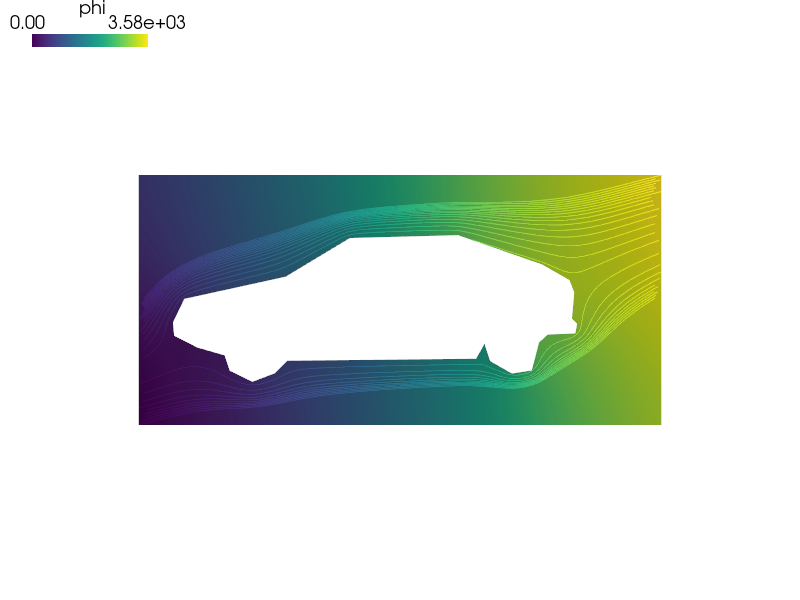diffusion/laplace_fluid_2d.py¶
Description
A Laplace equation that models the flow of “dry water” around an obstacle shaped like a Citroen CX.
Description¶
As discussed e.g. in the Feynman lectures Section 12-5 of Volume 2
(https://www.feynmanlectures.caltech.edu/II_12.html#Ch12-S5),
the flow of an irrotational and incompressible fluid can be modelled with a
potential  that obeys
that obeys

The weak formulation for this problem is to find  such that:
such that:

where  is the 2D vector defining the far field velocity that
generates the incompressible flow.
is the 2D vector defining the far field velocity that
generates the incompressible flow.
Since the value of the potential is defined up to a constant value, a Dirichlet boundary condition is set at a single vertex to avoid having a singular matrix.
Usage examples¶
This example can be run with the following:
sfepy-run sfepy/examples/diffusion/laplace_fluid_2d.py
sfepy-view citroen.vtk -f phi:p0 phi:t50:p0 --2d-view
Generating the mesh¶
The mesh can be generated with:
gmsh -2 -f msh22 meshes/2d/citroen.geo -o meshes/2d/citroen.msh
sfepy-convert --2d meshes/2d/citroen.msh meshes/2d/citroen.h5

r"""
A Laplace equation that models the flow of "dry water" around an obstacle
shaped like a Citroen CX.
Description
-----------
As discussed e.g. in the Feynman lectures Section 12-5 of Volume 2
(https://www.feynmanlectures.caltech.edu/II_12.html#Ch12-S5),
the flow of an irrotational and incompressible fluid can be modelled with a
potential :math:`\ul{v} = \ul{grad}(\phi)` that obeys
.. math::
\nabla \cdot \ul{\nabla}\,\phi = \Delta\,\phi = 0
The weak formulation for this problem is to find :math:`\phi` such that:
.. math::
\int_{\Omega} \nabla \psi \cdot \nabla \phi
= \int_{\Gamma_{left}} \ul{v}_0 \cdot n \, \psi
+ \int_{\Gamma_{right}} \ul{v}_0 \cdot n \, \psi
+ \int_{\Gamma_{top}} \ul{v}_0 \cdot n \,\psi
+ \int_{\Gamma_{bottom}} \ul{v}_0 \cdot n \, \psi
\;, \quad \forall \psi \;,
where :math:`\ul{v}_0` is the 2D vector defining the far field velocity that
generates the incompressible flow.
Since the value of the potential is defined up to a constant value, a Dirichlet
boundary condition is set at a single vertex to avoid having a singular matrix.
Usage examples
--------------
This example can be run with the following::
sfepy-run sfepy/examples/diffusion/laplace_fluid_2d.py
sfepy-view citroen.vtk -f phi:p0 phi:t50:p0 --2d-view
Generating the mesh
-------------------
The mesh can be generated with::
gmsh -2 -f msh22 meshes/2d/citroen.geo -o meshes/2d/citroen.msh
sfepy-convert --2d meshes/2d/citroen.msh meshes/2d/citroen.h5
"""
import numpy as nm
from sfepy import data_dir
filename_mesh = data_dir + '/meshes/2d/citroen.h5'
v0 = nm.array([1, 0.25])
materials = {
'm': ({'v0': v0.reshape(-1, 1)},),
}
regions = {
'Omega': 'all',
'Gamma_Left': ('vertices in (x < 0.1)', 'facet'),
'Gamma_Right': ('vertices in (x > 1919.9)', 'facet'),
'Gamma_Top': ('vertices in (y > 917.9)', 'facet'),
'Gamma_Bottom': ('vertices in (y < 0.1)', 'facet'),
'Vertex': ('vertex in r.Gamma_Left', 'vertex'),
}
fields = {
'u': ('real', 1, 'Omega', 1),
}
variables = {
'phi': ('unknown field', 'u', 0),
'psi': ('test field', 'u', 'phi'),
}
# these EBCS prevent the matrix from being singular, see description
ebcs = {
'fix': ('Vertex', {'phi.0': 0.0}),
}
integrals = {
'i': 2,
}
equations = {
'Laplace equation':
"""dw_laplace.i.Omega( psi, phi )
= dw_surface_ndot.i.Gamma_Left( m.v0, psi )
+ dw_surface_ndot.i.Gamma_Right( m.v0, psi )
+ dw_surface_ndot.i.Gamma_Top( m.v0, psi )
+ dw_surface_ndot.i.Gamma_Bottom( m.v0, psi )"""
}
solvers = {
'ls': ('ls.scipy_direct', {}),
'newton': ('nls.newton', {
'i_max': 1,
'eps_a': 1e-10,
}),
}